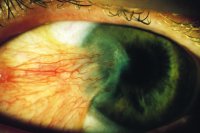pterygium
[tĕ-rij´e-um]a winglike structure, especially an abnormal triangular fold of membrane in the interpalpebral fissure, extending from the conjunctiva to the cornea.

Pterygium. From Stein et al., 2000.
pterygium col´li webbed neck.
Miller-Keane Encyclopedia and Dictionary of Medicine, Nursing, and Allied Health, Seventh Edition. © 2003 by Saunders, an imprint of Elsevier, Inc. All rights reserved.
pte·ryg·i·um
(tĕ-rij'ē-ŭm),1. A triangular patch of hypertrophied bulbar subconjunctival tissue, extending from the medial angle or canthus of the eye to the border of the cornea or beyond, with apex pointing toward the pupil. Synonym(s): web eye
2. Forward growth of the cuticle over the nail plate, seen most commonly in lichen planus. Synonym(s): pterygium unguis
3. An abnormal skin web.
[G. pterygion, anything like a wing, a disease of the eye, dim. of pteryx, wing]
Farlex Partner Medical Dictionary © Farlex 2012
pterygium
(tə-rĭj′ē-əm)n. pl. pteryg·iums or pteryg·ia (-ē-ə)
An abnormal mass of tissue arising from the conjunctiva of the inner corner of the eye that obstructs vision by growing over the cornea.
pte·ryg′i·al (-əl) adj.
The American Heritage® Medical Dictionary Copyright © 2007, 2004 by Houghton Mifflin Company. Published by Houghton Mifflin Company. All rights reserved.
pterygium
Ophthalmology A condition of older adults, characterized by a fleshy triangular fold of tissue that grows from the conjunctiva, encroaching on the cornea; it is clinically insignificant unless it affects the vision; it is usually on the nasal side, and may be bilateral Risk factors Exposure to sun and UV light, dust, sand, windMcGraw-Hill Concise Dictionary of Modern Medicine. © 2002 by The McGraw-Hill Companies, Inc.
pte·ryg·i·um
(tĕr-ij'ē-ŭm)1. A triangular patch of hypertrophied bulbar subconjunctival tissue, extending from the medial canthus to the border of the cornea or beyond, with its apex pointing toward the pupil.
2. Forward growth of the cuticle over the nail plate, seen most commonly in lichen planus.
3. An abnormal skin web.
[G. pterygion, anything like a wing, a disease of the eye, dim. of pteryx, wing]
Medical Dictionary for the Health Professions and Nursing © Farlex 2012
pterygium
A wing-shaped thickening of the CONJUNCTIVA that extends over the visible area of the white of the eye and across on to the CORNEA. Pterygium is common in tropical areas and is due to ultraviolet light damage from exposure to sunlight or to local corneal drying. Pterygium usually recurs following surgical removal. Also known as web-eye or duffir (Arabic).Collins Dictionary of Medicine © Robert M. Youngson 2004, 2005
pterygium
A triangular fold of bulbar conjunctiva, in the interpalpebral fissure, with its apex advancing progressively towards the cornea, usually from the nasal side. A pinguecula often precedes its development. It is considered to be due to a degenerative process caused by recurrent dryness or irritation from wind and dust or prolonged exposure to sunlight, especially UV. It becomes more prevalent with age. Symptoms are usually absent unless the pterygium encroaches on the cornea and vision may then be affected: surgical intervention is then necessary. Some pterygia tend to recur after excision. UV absorptive lenses may help decrease the incidence (Fig. P21). See dellen; dyskeratosis; Stocker's line; pseudopterygium.
Millodot: Dictionary of Optometry and Visual Science, 7th edition. © 2009 Butterworth-Heinemann
pte·ryg·i·um
(tĕr-ij'ē-ŭm)1. Triangular patch of hypertrophied bulbar subconjunctival tissue, extending from medial angle or canthus of eye to border of cornea or beyond, with apex pointing toward pupil.
2. Forward growth of the cuticle over the nail plate, seen most commonly in lichen planus.
[G. pterygion, anything like a wing, a disease of the eye, dim. of pteryx, wing]
Medical Dictionary for the Dental Professions © Farlex 2012
